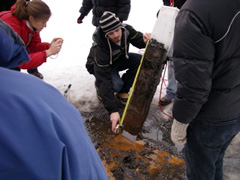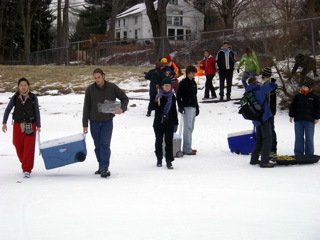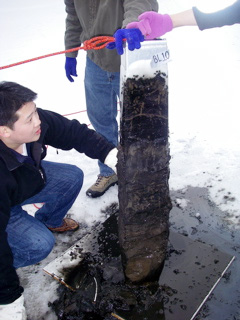Class Uses Local Lake as Laboratory
| Posted 06/04/07 |
| About 30 years ago, unnatural and excessive biological growth started occurring in the small, man-made Beseck Lake six miles southeast of Wesleyan’s campus.
Septic systems from lakeside homes deposited nutrients into the water, altering the biogeological cycles of carbon, sulfur, nitrogen and phosphorus in the aquatic ecosystem. By 2002, the problem was remedied by connecting the homes to a city sewer system and the quality of the lake water improved. However, excess algae growth continued to form, proving that some unwanted nutrients continued to exist. What was still polluting the lake? asked Tim Ku, assistant professor of earth and environmental science. Ku and 18 Wesleyan students volunteered to help find the answers. As part of Wesleyans Service Learning Course, Environmental Geochemistry Laboratory, the students had an opportunity to research the lake focusing on cultural eutrophication or the result of nutrient pollution in an ecosystem.
The students broke into small groups to conduct individual studies. During the winter they cut holes frozen-over lake (pictured) and lowered probes into the water and sediment. The sediment measurements allowed the young researches to identify changes that have occurred in the lake since 1849, when the lake was created. Students also analyzed the lakes water and the surrounding air. Sarah Gillig 09, an earth and environmental studies major, worked on an organic sediment deposit study. Her goal was to find what was still causing the pollution in the lake, which can harm people and kill fish and natural aquatic life. We wanted to know if the problems were caused by outside factors, such as external organic pollution, runoff from a nearby mountain, or if they were internal, Gillig explains. We ultimately discovered they were internal.
Emily Keeler 07, an earth and environmental sciences major, says she took the Service Learning Class because shes interested in the ways that humans impact environments. Keeler focused her Beseck Lake studies on water chemistry. By measuring the levels of dissolved oxygen, Keeler was able to investigate the magnitude of oxygen depletion and also whether the lake is overturning and mixing. She and her peers calculated alkalinity and measured ion concentrations in the water to determine existing contaminations. Its difficult to look at this ecosystem and see how its being destroyed, Keeler says. People want to use it for recreation. They aren’t necessarily thinking about the fact that in order for the lake to not be eutrophic depends on a balanced lake ecosystem. That means theyre going to have to change parts of their lifestyle, like not using chemical fertilizers that run into the lake. Ku says once excess phosphate enters the lake, much of it is continuously cycled from the sediments into the water column. The Town of Middlefield has submitted a $100,000 bond proposal to the Connecticut State Bond Commission to improve the water quality and clarity of Beseck Lake. The bond has been approved by the Environment Committee and the Finance Committee, and is awaiting a vote.
There is no easy solution for eutrophication at Beseck Lake, the nutrients can be very difficult to remove or inactivate, Ku says. Hopefully, the class research will lead to the remediation of the lake. The Service Learning project was held in cooperation with the Beseck Lake Association. Students took turns presented their finding to 35 members of the lake community on May 8. For a long time we have wondered whether the nutrients in the lake were caused by leaves washing down the mountain, farm animals that live on either end of the lake, or sewage that is stored in the sediment after 75 years of septic tank leakage, says Richard Boynton, president of the Beseck Lake Association. The students answered this question. Middlefield is lucky that Wesleyan provided this valuable research study, which would have otherwise cost us thousands of dollars. Gillig says the Service Learning program is a valuable addition at Wesleyan, and provides them with practical experience in things that are otherwise very abstract. Once you’ve done it yourself, you have a completely different comprehension and appreciation for things, she says. |
| By Olivia Drake, The Wesleyan Connection editor. Photos contributed by Tim Ku and his class. |


 Prior to conducting the actual research, Ku taught the class a variety of geochemical analytical techniques. Classes were held on campus but the 116-acre Beseck Lake served as the laboratory.
Prior to conducting the actual research, Ku taught the class a variety of geochemical analytical techniques. Classes were held on campus but the 116-acre Beseck Lake served as the laboratory. Jordan Schmidt 08, earth and environmental sciences major, analyzed the amount of phosphate in the lakes sediment. High phosphate levels can result in excess algae growth.
Jordan Schmidt 08, earth and environmental sciences major, analyzed the amount of phosphate in the lakes sediment. High phosphate levels can result in excess algae growth. To solve the algae problem, the class investigated the use of alum, a compound that binds phosphate. While this treatment could decrease the algae blooms at Beseck Lake the students cautioned that an alum application must be carefully designed and monitored. Too much alum may harm aquatic life such as fish; too little will not inhibit the algae growth.
To solve the algae problem, the class investigated the use of alum, a compound that binds phosphate. While this treatment could decrease the algae blooms at Beseck Lake the students cautioned that an alum application must be carefully designed and monitored. Too much alum may harm aquatic life such as fish; too little will not inhibit the algae growth.